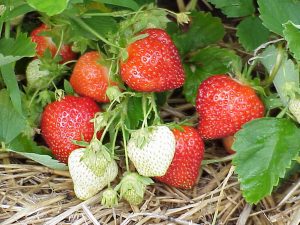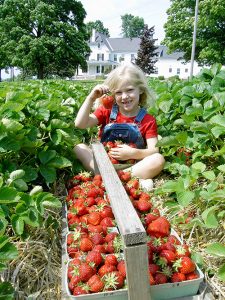Strawberry IPM Newsletter No. 5 – June 17, 2022

Strawberry IPM Newsletter No. 5 – June 17, 2022
HARVEST BEGINS IN SOUTHERN MAINE
Gray Mold, Anthracnose Fruit Rot Concerns in Ripening Fields
Situation: Harvest of early varieties is underway in southern Maine. Cooler weather predicted for next week may slow the maturity of later varieties, which could help extend the season, but hopefully won’t keep the supply of ripe fruit too low for demand.
Two-spotted spider mites: Continue scouting for mites, even as harvest begins, to determine if management will be needed during and after bed renovation. For now, mite populations remain low, and cooler weather should keep them from going up over the next week.
Tarnished plant bug numbers have been very low, but nymphs could still be a problem on late varieties in northern sites. Growers should continue to scout for the active, yellow-green nymphs on developing fruit and be prepared to control them if numbers exceed the threshold of 4 or more nymphs per 30 flower clusters examined.

Sap beetles are sometimes a problem as we start harvesting berries. The 1/8 inch long, dark brown beetles chew small holes in ripening fruit, like slug injury. They may be seen in the holes they’ve chewed into ripe fruit, but often drop to the ground when disturbed. The best management strategy for sap beetles is good sanitation. Keep the field free of overripe fruit by picking often and thoroughly. Insecticide sprays for this pest can be effective but should be a last resort during the harvest period. Brigade®, Assail® Dibrom® and PyGanic® are registered for control of sap beetles with pre-harvest intervals ranging from 12 to 24 hours. Read the product label carefully for this and other application instructions and restrictions.
Slugs can be a problem on ripe fruit, especially in fields that have been heavily mulched. Moist conditions encourage the presence of these mollusks. Slugs usually feed at night, leaving large holes in the leaves and tunnels in the ripening fruit. Baits such as Deadline® and Sluggo® offer some control of slugs but should be used prior to fruit ripening. Pay close attention to label instructions and precautions. Baits should also be applied to the fields in mid-September if slugs have been a problem, to reduce egg-laying.
Diseases: Growers with fields still in bloom should keep protecting blossoms from gray mold infection through petal fall. Two to three sprays of fungicide during bloom are typically required to provide good protection against this disease, especially if fields remain wet for extended periods of time.

Anthracnose fruit rot: As the fruit ripens in fields that are wet from irrigation or rainfall, be on the lookout for anthracnose. This disease is favored by warm, humid conditions and can spread rapidly via splashing water during rain or irrigation events, especially if puddles remain in a field. Anthracnose appears as black sunken lesions on the berries with orange spore masses in them. The fungus can multiply on leaves without visible symptoms, which is why it may appear suddenly and widespread in a field. Recommended fungicides include Pristine®, Cabrio®, and Abound®.
Powdery mildew: We haven’t powdery mildew on foliage yet, but it may become a problem in the coming days. Look for upward cupping of the leaves and reddish streaking or lesions on the leaf and flower stems. Consider using a fungicide that will control powdery mildew, such as captan + Topsin-M®, or Pristine® if you’re still spraying for gray mold.
Annual Pre-Harvest Checklist for Pick-Your-Own
Is your farm ready to provide your customers with the best possible picking experience? This is especially important with the continuing challenges of the coronavirus pandemic. Inform your customers of new guidelines, including social distancing and sanitation protocols, so they know what to expect when they arrive on your farm.
- Your phone message and web/social media pages with picking conditions and opening and closing times should be regularly updated and provide information about how fields are being managed to protect customers from COVID-19.
- There is easy access to the fields and plenty of parking. If possible, entries and exits should be on opposite sides of the lot to reduce cross traffic and congestion.
- Someone is ready to greet customers and offer parking instructions and directions to the field. Protective face masks or shields should be worn by staff and customers when indoors. Disposable masks should be available for customers.
- Access to the field is free of hazards. Entries and exits should be on opposite sides of the field. All foot traffic should be one way up the rows. Use flags to mark where the last customer stopped picking, and the next should begin, Customers should stay in assigned rows and not allowed to be within 6 feet of other customer groups.
- If transportation is provided for the elderly and disabled, follow social distancing as much as possible, e.g., no group transportation, and as much space as possible between riders and drivers.
- The rules regarding picking, distancing, sanitation, and traffic flow are clearly posted.
- Someone is in the field to show customers where to pick, explain picking guidelines, and answer questions.
- Restroom and hand washing facilities are available and regularly cleaned and sanitized. Customers should wash their hands before entering the field. Instructions for proper hand washing should be posted.
- Fruit and containers should be handled as little as possible. Have shields set up at weigh stations and checkouts between customers and staff. Scales and countertops should be sanitized frequently. Customers should maintain distancing during the checkout process. The entry and exit from the checkout should be one-way, with no cross traffic.
- No playgrounds, petting zoos, picnic areas, etc. Customers should be discouraged from congregating at the farm, especially indoors.
- The help is friendly and knowledgeable.
 The pandemic has forced us to limit the social aspects of the pick-your-own experience, but by keeping customers informed about your concerns for safety and providing a friendly, clean, efficient, and organized atmosphere, you will build trust and good faith with them, encouraging them to return and recommend your farm to their friends.
The pandemic has forced us to limit the social aspects of the pick-your-own experience, but by keeping customers informed about your concerns for safety and providing a friendly, clean, efficient, and organized atmosphere, you will build trust and good faith with them, encouraging them to return and recommend your farm to their friends.
COVID-19 information for farmers: For more information regarding growing and marketing crops under COVID-19 restrictions please visit our webpage:
https://extension.umaine.edu/agriculture/
You can get quick access to strawberry IPM information through the UMaine Highmoor Farm news blog at:
https://extension.umaine.edu/highmoor/news-events/ or the UMaine Pest Management web page at https://umaine.edu/ipm/. If you have questions about the Newsletter, please give us a call at 207.933.2100 or send an e-mail message to me at:
Sincerely,
David T. Handley
Vegetable and Small Fruit Specialist
Highmoor Farm Pest Management Unit
P.O. Box 179 17 Godfrey Dr.
Monmouth, ME 04259 Orono, ME 04473
207.933.2100 1.800.287.0279
Where brand names or company names are used, it is for the reader’s information. No endorsement is implied nor is any discrimination intended against products with similar ingredients. Always consult product labels for rates, application instructions and safety precautions. Users of these producers assume all associated risks.
The University of Maine is an equal opportunity/affirmative action institution.
